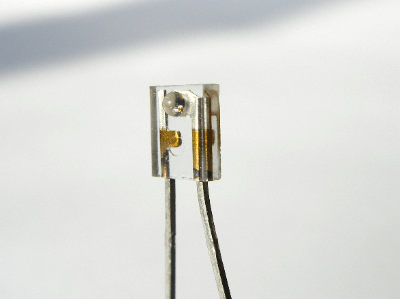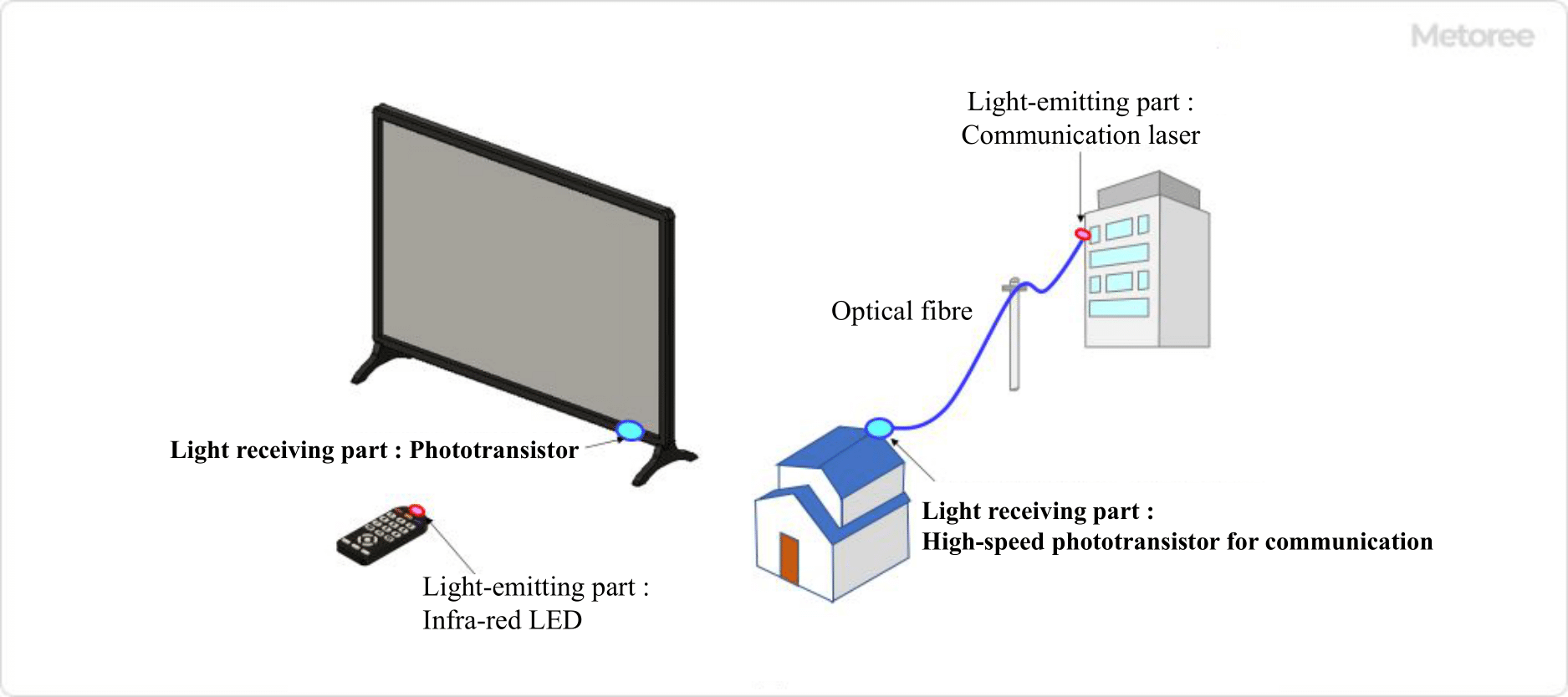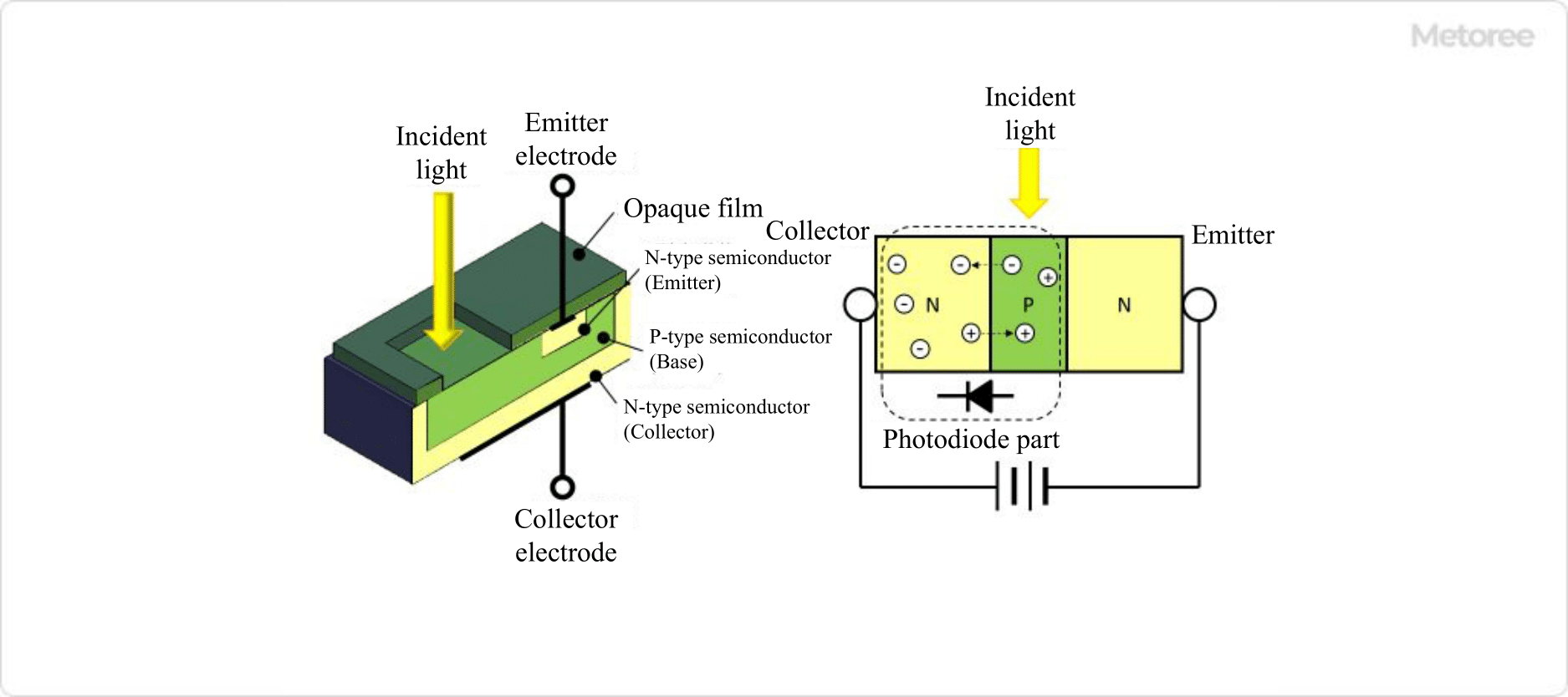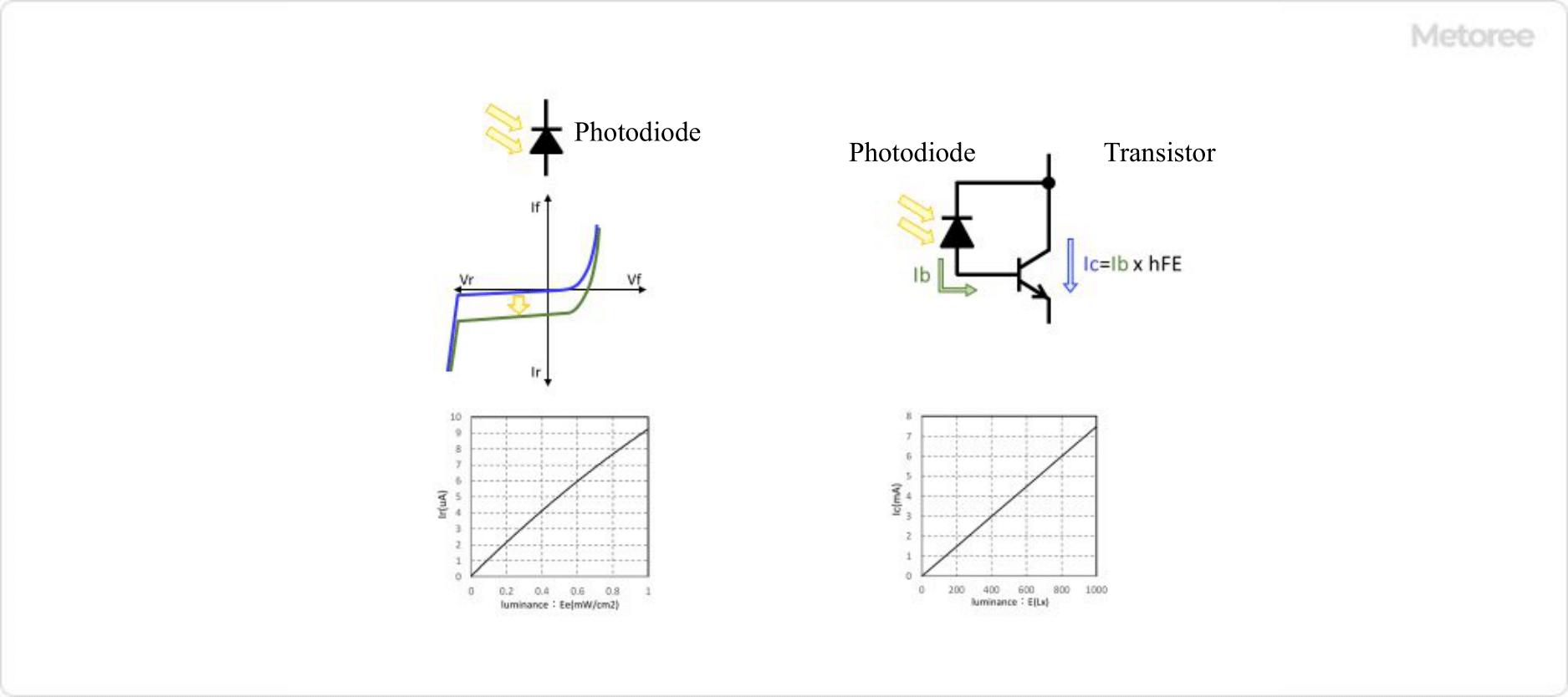All Categories
History












This section provides an overview for phototransistors as well as their applications and principles. Also, please take a look at the list of 20 phototransistor manufacturers and their company rankings. Here are the top-ranked phototransistor companies as of July, 2025: 1.Light in Motion LLC, 2.STANLEY Electronic Components, 3.Vishay Intertechnology, Inc.,.
Table of Contents
 A phototransistor is a semiconductor device used to detect light.
A phototransistor is a semiconductor device used to detect light.
Its structure is a combination of a phototransistor and a photodiode. Since they are available in a variety of shapes depending on the package, they must be selected appropriately for each application.

Figure 1. Uses of phototransistors
Phototransistors are widely used as light-receiving sensors. In particular, since they have a peak sensitivity around 800 nm, they are generally used to receive infrared light.
Specific examples of phototransistor applications include "light intensity measurement," "infrared remote control receivers," "photoelectric sensor receivers," and "optical communications." In particular, they are often used in combination with infrared LEDs in remote controls for TVs and air conditioners.
One application of optical communication is the gigabit optical communication service provided by internet providers. The light receiving part of that communication uses high-speed phototransistors, which are ideal for communication.
Phototransistors are also sometimes used as sensors in automatic doors. Furthermore, since phototransistors generate electric current by detecting light, they are used as switches driven by light, and so on.

Figure 2. Structure of phototransistor
Phototransistors are semiconductor devices with an NPN structure. This NPN structure allows the phototransistor to produce a larger output signal than a photodiode.
The NPN structure of the phototransistor amplifies the output of the photodiode with a transistor. When light equivalent to the energy gap of the semiconductor enters the transistor, electrons in the valence band are excited to the conduction band.
This causes migration to the N layer, and holes move to the P layer. This transfer from the N layer to the P layer causes a forward bias at the junction, which results in a current flow.
The transistor used in phototransistor is characterized by the fact that it does not have a base electrode. However, the photocurrent generated by light reception becomes the base current, and this base current is amplified by the collector.
The amplification of the base current is hFE (transistor amplification factor) times as large as that of other transistors. However, as a characteristic of phototransistors, even if the hFE is the same, there is a tendency to use a relatively large hFE.
This allows a large collector current to be drawn from the tiny photodiode signal, but it should be noted that current is always leaking at the collector-base junction, and this leakage current is also amplified.
In other words, phototransistors have a weak current flow even in a completely dark environment. This weak current that flows even in a dark environment is called dark current. The dark current generated by a phototransistor is an internal noise as a light sensor. However, it is possible to suppress this internal noise.
The dark current has the characteristic of increasing when the temperature is high and, conversely, decreasing when the temperature is low. Therefore, internal noise can be suppressed by cooling the device using this characteristic.

Figure 3. Photodiode and transistor
The IV characteristic of a photodiode shifts downward in response to the intensity of light (blue line becomes green line) when it is exposed to light. This change in IV characteristic is the standard for measuring light intensity. However, since the output current is in the order of uA, the output as it is would complicate the circuitry in the subsequent stages.
By combining a phototransistor with a photodiode and a transistor, it is possible to amplify the photocurrent generated when light is received by the photodiode by a factor of hFE, the DC current amplification factor of the transistor. Therefore, the phototransistor is more sensitive than the photodiode, and the output current of the phototransistor is in the order of mA, thus simplifying the circuitry in the subsequent stages.
Phototransistors are several hundred times more sensitive than photodiodes, and if even higher sensitivity is required, the use of a Darlington-connected phototransistor can provide several hundred times x several hundred times higher sensitivity. This makes it possible to detect brightness of several Lux.
A CDS is a photoresistor, also called a CDS cell or a photoconductive cell. That is, the resistance increases when the illuminance is low and decreases when the illuminance is high.
The advantages of CDS are that the minute sensitivity characteristic is close to that of human vision. The structure is simple; the sensitivity is high, and the price is low.
For example, they are used in illuminance meters, exposure meters for cameras, and brightness detectors for automatic flashing lights. However, cadmium sulfide, the main material used as an element in CDS, is an environmentally harmful substance. For this reason, the use of CDS has been decreasing in recent years.
Phototransistors, on the other hand, provide an output current proportional to illuminance. Another advantage of phototransistors is their high sensitivity because of their structure, which combines a photodiode and a transistor.
*Including some distributors, etc.
Sort by Features
Sort by Area

Kingbright Company LLC is a manufacturer of LED products that provide solutions for enhanced connectivity and visualization, headquartered in Taipei, Taiwan. They offer product lines in both visible and invisible spectrums, which are used in a wide range of industries for motion control and automation applications. Some of their products include High-Temperature SMD LEDs, Super Low-Profile RA Bi-Color, RGB in CBI, IR Dome LENs SMD LEDs, and APGF0606 Series. Kingbright has sales offices around the world, including the US, Europe, and Asia. Kingbright Company LLC is certified with ISO 9001:2015 standards.

Clairex Semiconductor, established in 2017, and located in Plano, Texas, is a manufacturer that specializes in design and produces optoelectronic components. The company offers a range of products related to optoelectronics, including IREDs, LEDs, photodiodes, and phototransistors. It also offers both custom-designed and standard optoelectronic components. Its products emit radiation from the junction at wavelengths dependent on the bandgap energy of the dopants used in the processing. Its products are suitable for use in commercial, medical, and military.

Light in Motion LLC, founded in 2009, is a manufacturer of standard and custom hermetically sealed optoelectronics components, headquartered in Milpitas, California. Some of the optoelectronics components offered, which are used in sensing applications include light-emitting diodes, optical interrupters, switches, emitters, and detectors. They also provide assemblies and photosensors. The company serves the sensor industry and is RoHS-compliant. Light in Motion's Engineering Group, situated in California, collaborates with their factories in Asia, ensuring adherence to ISO 9001 standards throughout the entire product lifecycle.

Excelitas Technologies Corp., headquartered in Waltham, USA, is a manufacturer of photonic solutions. The company provides photonic solutions for the illumination, optical and imaging needs of the OEM and end-user customers. The products like cameras, sensors and light sources serve an array of applications across many sectors. These range of applications include clinical diagnostics, autonomous vehicles and X-ray security screening. The company also offers bespoke photonic solutions such as discrete components, sub-assemblies, or complete turnkey solutions tailored to the customers' specific requirements.

Vishay Intertechnology, Inc. (Vishay) was incorporated in 1962 and is headquartered in Malvern, Pennsylvania. The company serves the industrial, automotive, telecommunications, consumer products, and medical end markets and sells its products under numerous brand names inlcuding Siliconix, Draloric, Beyschlag, UltraSource, and Applied Thin-Film Products. The company manufactures and sells discrete semiconductors and passive electronic components in globally while operating in six market segments: MOSFETs, diodes, optoelectronic components, resistors, inductors, and capacitors.

Rochester Electronics, LLC is a manufacturer stocking distributor of end-of-life semiconductors and the broadest range of active semiconductors that is headquartered in Newburyport, Massachusetts, and was founded in 1981. The company caters to manufacturing services ranging from design, wafer processing, testing, reliability, and IP Archiving. These specifically include OCM, build-to-order products, process flows, and standard packaging creation. The company pivots on manufacturing and distributing semiconductors that are no longer produced by its original manufacturer.

Allied Electronics Inc., founded in 1991 with headquarters in the USA, is a distributor and supplier of fuel and vehicle servicing station equipment and accessories. The company's extensive product line of over 57,000 products includes forecourt controller parts, fuel dispenser parts, air compressors, and power conditioners. The company also provides rebuilt parts by brands that include Bennett, Daktronics, FE-Petro, and Gasboy. The company's services include equipment financing, primarily serving the retail petroleum industry, including car wash and price sign manufacturers.

Located in Austria and Germany, Ams-Osram is a sensor design and manufacturing company that specializes in compact form factors, low power, high sensitivity, and multi-sensor applications. They were established in 1981 and were formerly known as austriamicrosystems AG. In 2012 it changed its name to ams AG. They have a technology portfolio for sensing, lighting, and visualization, ranging from light emitters and optical components to micro-modules, integrated circuits, and related software. Their work develops technology for use in the consumer, industrial, medical, and automotive sectors.

Shinkoh Electronics, established in 1974, is a manufacturer and retailer of electrical semiconductor products based in Kanagawa, Japan. The company’s product portfolio is composed of photo reflectors, prism photo sensors, photo interrupters, and photo interrupter separator-type & actuator-type. Their products are used in various settings including in amusement machines, slot machines, and cash machines for object detection, button detection, coin/bill passing detection, barcode reading, and mark detection. They are also used in testing equipment and medical and analytical equipment for various mechanism detection, and cover & object detection.

Stanley Electric Co., Ltd is a Japanese manufacturer of electric lights established in the year 1933. Stanley Electric Co Ltd makes LED ignited products and operates under three business segments: automotive equipment, electronic components, and applied electronic products. In its automotive equipment business, Stanley Electric produces and sells LED and HID headlamps, rear combination lamps, fog lamps, and automotive and LED bulbs. In its other segments, Stanley Electric makes LEDs, infrared LED lamps, optical sensors, LCDs, subminiature lamps, backlight units for LCDs, flash units for cameras, and operation panels. The largest end markets include Japan, China and Asia-Pacific, and the Americas.

Harvatek is a Taiwanese manufacturer and supplier of LEDs (light-emitting diodes) and optoelectronic components. Established in 1997 and specializes in the design, development, and production of a wide range of LED products, including SMD LEDs, through-hole LEDs, and custom-designed LED modules. One of their LED products is the high-power LED series, which includes the RGBW LED, white LED, and blue LED, designed to provide high brightness, long lifespan, and energy efficiency, making them ideal for various applications such as automotive lighting, outdoor lighting, and commercial lighting. They won awards such as Taiwan Excellence Award, Outstanding SME Award, and the National Innovation Award.

Osram Opto Semiconductors, a company founded in 1999, based in Regensburg, Germany, is a manufacturer of optoelectronic semiconductors for illumination, sensing, and visualization sectors. The company offers various semiconductor products such as visible-light LEDS, high-performance infrared LEDS, optoelectronic detectors, and semiconductor lasers. These products are sold in various output categories with different sizes, brightness levels, and packaging formats. The company also offers various support that include customer-specific LED colors, intelligent sensor modules, and brand-specific headlight designs to meet customer specification.

Hamamatsu Photonics K.K., established in 1953 and headquartered in Hamamatsu, Japan, is a manufacturer of sensors and emitters for both visible and invisible light. It stocks products like LEDs, lamps, and photodiodes used in several industries, including consumer electronics, dental imaging, and environmental monitoring. The sensor and light source components are also available as modules and units that can be incorporated into systems the company develops, like optical measurement systems or imaging systems. The ISO 9001-certified company stocks over 15,000 devices, units, and systems that ship to over 100 destinations worldwide, and it has ten research and production bases.

Isobaud Inc., based in Santa Clara, California, is a manufacturer of optoelectronic devices and sensors serving industries such as healthcare, military, and aerospace. Its products include optocouplers, infrared emitters, and magnetic digital isolators, and it also works with end users to deliver custom solutions. The company’s IB14C1 and IB14C2 radiation-tolerant phototransistors consist of silicon phototransistors mounted in a wide-angle hermetic TO-18 package and have an operating temperature of -65°C to +125°C. The IB8240, IB8241, and IB8242 magnetic digital separators can attain speeds of up to 150mbps and have a 60-year life at rated working voltage.

LEDidea, founded in 1996 in Taiwan, is a manufacturer and supplier of quality LED lighting solutions. The company's main products include LED bulbs, tubes, strips, and modules used in various applications, including residential, commercial, and industrial lighting.LEDidea's LED lighting products offer energy-efficient and long-lasting illumination, contributing to energy conservation and sustainability. With an aim of research and development, LEDidea continuously introduces new LED lighting solutions to cater to the evolving needs of the lighting industries. The company is customized to providing good and affordable LED lighting solutions that enhance the lighting experience for its customers.

Tyntek Corporation, established in 1987, and based in Taiwan, China, is a manufacturer and supplier of quality optoelectronic and LED lighting products. Tyntek offers a wide range of products, including LED lamps, displays, and modules, serving various industries such as automotive, consumer electronics, and industrial applications. Courtesy of its wide research and development capabilities, Tyntek provides new and energy-efficient solutions that meet the evolving needs of its customers. As a dependable provider of optoelectronic solutions, Tyntek continues to deliver good products and perfect customer service to clients worldwide.

Kodenshi Corp. is an ISO 14001 and IATF 16949-certified manufacturer of optical devices that was established in 1972 in Kyoto, Japan. The company’s product lineup includes photointerrupters for sensing motion or positioning, photodiodes for converting light into electrical currents, and phototransistors for amplifying currents generated by photodiodes. It also offers encoders for converting motion into digital signals, and photo couplers for noise reduction or signal isolation. The company’s products are commonly used within the private security and transportation sectors, and have additional applications in the automotive industry.

Kingbright Electronic Co. Ltd., founded in 1980, is a light-emitting diode (LED) product manufacturer headquartered in New Taipei City, Taiwan. Certified with ISO 9001 and ISO 14001, the company offers surface-mounted device (SMD) LEDs and displays, through-hole LED lamps and displays, as well as circuit board indicators. Other products include a range of infrared-emitting diodes and phototransistors. Notably, the company manufactures its products using lead-free materials, complying with the European Union (EU) Restriction of Hazardous Substances (RoHS) directive. These products find applications in the automotive, consumer electronics, and lighting sectors.

ROHM Semiconductor was incorporated in 1940 and is headquartered in Kyoto, Japan. ROHM manufactures and sells electronic components worldwide. ROHM operates through the segments ICs, discrete semiconductor devices, and modules. ROHM provides ICs comprising memory, amplifiers and linear, power management, clocks and timers, switches and multiplexers, logic, data converters, sensors and MEMS, display drivers, motor/actuator drivers, interfaces, communication and speech synthesis LSI, audio and video, and microcontrollers. ROHM also offers discrete semiconductor products include MOSFETs, bipolar transistors, and diodes; power devices, including power transistors and diodes, SiC power devices, IGBT, and IPM; passive devices, such as resistors, and conductive polymer and tantalum capacitors; and various modules among others.

Ranking as of July 2025
Derivation Method| Rank | Company | Click Share |
|---|---|---|
| 1 | Vishay Intertechnology, Inc., |
10.7%
|
| 2 | Light in Motion LLC |
9.8%
|
| 3 | STANLEY Electronic Components |
9.4%
|
| 4 | Harvatek Corporation |
8.0%
|
| 5 | Kingbright Company, LLC |
7.1%
|
| 6 | ROHM Co., Ltd. |
6.7%
|
| 7 | Tyntek |
6.7%
|
| 8 | IDEA, Inc. |
6.7%
|
| 9 | Hamamatsu Photonics K.K. |
6.7%
|
| 10 | ams OSRAM AG |
5.4%
|
Derivation Method
The ranking is calculated based on the click share within the phototransistor page as of July 2025. Click share is defined as the total number of clicks for all companies during the period divided by the number of clicks for each company.Number of Employees
Newly Established Company
Company with a History
*Including some distributors, etc.
*Including some distributors, etc.
| Country | Number of Companies | Share (%) |
|---|---|---|
 United States of America
United States of America
|
7 | 50.0% |
 Japan
Japan
|
4 | 28.6% |
 Austria
Austria
|
2 | 14.3% |
 Taiwan
Taiwan
|
1 | 7.1% |
54 products found
54 products
Aruwan Electronics Co., Ltd.
430+ people viewing
Last viewed: 19 hours ago
These are ultra-compact photodiodes and phototransistors with a diameter of 3 mm, and are very effective when the design does not allow for a lot o...
Aruwan Electronics Co., Ltd.
240+ people viewing
This is a visible light receiving sensor developed as an alternative to LDR (CDS). It is sensitive in the visible light region and provides output ...
Opto Techno Co., Ltd.
290+ people viewing
Last viewed: 1 day ago
■High performance due to advanced diffusion technology. ・Low dark current. ・High sensitivity and high quality element. ・Phototransistor can supp...
Towa Electronics Co., Ltd.
220+ people viewing
Last viewed: 1 day ago
Transistor output products are used in a wide range of applications, including voltage feedback circuits for power supplies and interfaces for indu...
Aruwan Electronics Co., Ltd.
310+ people viewing
Last viewed: 47 minutes ago
This is a visible light receiving sensor developed as an alternative to LDR (CDS). It is sensitive in the visible light region and provides output ...
Aruwan Electronics Co., Ltd.
320+ people viewing
Last viewed: 1 hour ago
This is a resin-coated sensor that uses photoconductivity and uses a package from φ4 to 20 mm, and is available in a wide variety of bright resista...
Aruwan Electronics Co., Ltd.
280+ people viewing
Last viewed: 2 hours ago
We offer light-receiving elements that meet your needs in a variety of package and element combinations, such as cans and mold types with lenses th...
Aruwan Electronics Co., Ltd.
300+ people viewing
Last viewed: 1 day ago
These are ultra-compact photodiodes and phototransistors with a diameter of 3 mm, and are very effective when the design does not allow for a lot o...
Unitech Co., Ltd.
270+ people viewing
Last viewed: 19 hours ago
US7500 is a silicon phototransistor that incorporates an NPN type silicon phototransistor chip into a ceramic stem. ■Features ・High sensitivity p...
Unitech Co., Ltd.
140+ people viewing
Last viewed: 1 day ago
UB1251 is a separate photosensor that uses an infrared light-emitting diode and a high-sensitivity phototransistor. ■Features ・Small and long-dis...
Unitech Co., Ltd.
230+ people viewing
Last viewed: 22 hours ago
US7510 is a resin-molded Φ3 bullet-shaped high-sensitivity silicon phototransistor. ■Features ・High sensitivity phototransistor ・Small size Φ3m...
Unitech Co., Ltd.
170+ people viewing
Last viewed: 59 minutes ago
UB1250 is a separate photosensor that uses an infrared light-emitting diode and a high-sensitivity phototransistor. ■Features ・Small and long-dis...
Unitech Co., Ltd.
250+ people viewing
US7511 is a resin-molded Φ3 bullet-shaped high-sensitivity silicon phototransistor. ■Features ・Visible light cut high sensitivity phototransisto...
Unitech Co., Ltd.
170+ people viewing
Last viewed: 13 hours ago
UB1252 is a separate photosensor that uses an infrared light emitting diode and a photo IC. ■Features ・Long distance detection possible (1-100mm)...
Unitech Co., Ltd.
250+ people viewing
US7571 is a resin-molded Φ5 bullet-shaped visible light cut high sensitivity silicon phototransistor. ■Features ・Visible light cut high sensitiv...
Unitech Co., Ltd.
270+ people viewing
Last viewed: 9 hours ago
UR1500 is a retroreflective photosensor that uses an infrared light-emitting diode and a high-sensitivity phototransistor. ■Features ・Ultra-compa...
Unitech Co., Ltd.
240+ people viewing
US8500 is a silicon phototransistor that incorporates an NPN silicon phototransistor chip into a 3228PLCC. ■Features ・External size 3.2×2.8×1.9 ...
Unitech Co., Ltd.
310+ people viewing
Last viewed: 1 hour ago
UR1501 is a retroreflective photosensor that uses an infrared light-emitting diode and a high-sensitivity phototransistor. ■Features ・Ultra-compa...
Luckylight Electronics Co., Ltd
240+ people viewing
Last viewed: 2 hours ago
■Summary A phototransistor is a three-terminal (emitter-base-collector) or two-terminal (emitter-collector) semiconductor device with a light-sensi...
Unitech Co., Ltd.
240+ people viewing
Last viewed: 5 hours ago
The UI1428 is a dust-proof transparent photo IC sensor with a flat detection slit and an operation indicator that lights up when an object is detec...
Luckylight Electronics Co., Ltd
230+ people viewing
■Summary A phototransistor is a three-terminal (emitter-base-collector) or two-terminal (emitter-collector) semiconductor device with a light-sensi...
Luckylight Electronics Co., Ltd
220+ people viewing
Last viewed: 15 hours ago
■Summary A phototransistor is a three-terminal (emitter-base-collector) or two-terminal (emitter-collector) semiconductor device with a light-sensi...
Luckylight Electronics Co., Ltd
260+ people viewing
Last viewed: 2 hours ago
■Summary A phototransistor is a three-terminal (emitter-base-collector) or two-terminal (emitter-collector) semiconductor device with a light-sensi...
Würth Elektronik
180+ people viewing
Last viewed: 16 minutes ago
■Features ・Small standard package size Perfect match for IR and visible light emitters ・High reliability ・High sensitivity ■Application ・Secur...
Würth Elektronik
290+ people viewing
Last viewed: 1 day ago
■Features ・High insulation voltage ・Good internal isolation stability ・Stable CTR with full operation ・Various CTR binning options available ・...